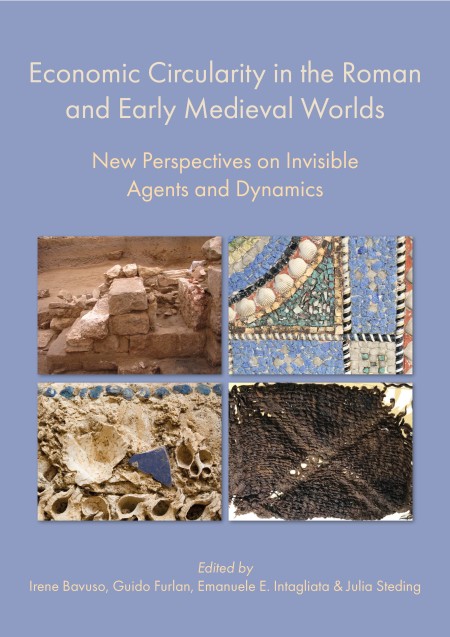Economic Circularity in the Roman and Early Medieval Worlds: New Perspectives on Invisible Agents and Dynamics
New publication edited by Irene Bavuso, Emanuele E. Intagliata, Guido Furlan, and Julia Steding.

The study on the reuse of building materials has a long history. Improvements in archaeometric analyses means that the study of glass and metal as recyclable products have been increased. Yet, other materials as well as agents involved in circular practices have stayed largely invisible, and processes such as maintenance, remanufacturing, or curation are rarely addressed.
In 13 chapters, the new conference proceedings explore the phenomenon of reuse in premodern societies. Reuse is generally understood as the ability of a society to reduce waste by recycling, reusing, and repairing raw materials and finished products. Traces of reuse and economic circularity can be found everywhere, and the case studies in this edited volume are proof of this.
The editors, coming together with their research interests on reuse practices, invited scholars studying agents of circular economies, such as junk dealers and scavengers, the reuse and recycling of glass, textiles, metal, stone, and jewelry, as well as methodological approaches to reuse, such as the perks and pitfalls of 3D scanning and provenance analyses.
To just highlight a few of the circular practices revealed in this book; did you know that there must have been a systematic collection of old textiles to waterproof hulls? Or that glass could be reused without being remelted, simply by including reworked glass sherds in mosaics? Or that there must have been, despite strict laws, some kind of organization behind the reopening of graves in the early medieval period?
The new publication is adding important information to past economies and their functioning and study the pragmatic, symbolic, and conscious choices made.
The edited volume is the outcome of a conference held in September 2022 at Moesgaard Museum, Aarhus (Denmark). The conference and the proceedings were generously funded by the Carlsberg Foundation (grant CF22-0013) and the Centre for Urban Network Evolutions (grant DNRF119).
Read more about the publication here: https://www.oxbowbooks.com/9781789259964/economic-circularity-in-the-roman-and-early-medieval-worlds/
Full reference
Bavuso, I., Furlan, G., Intagliata, E. E. & Steding, J. (eds). 2023. Economic Circularity in the Roman and Early Medieval Worlds: New Perspectives on Invisible Agents and Dynamics (Oxford: Oxbow).
UrbNet-related chapters
Bavuso, I., Furlan, G., Intagliata, E. E. & Steding, J. 2023. ‘Introduction: approaching circular economies through archaeological and historical sources, in: Bavuso, I., Furlan, G., Intagliata, E. E. & Steding, J. (eds). 2023. Economic Circularity in the Roman and Early Medieval Worlds: New Perspectives on Invisible Agents and Dynamics, Oxford: Oxbow, ix-xv.
Bavuso, I. 2023. ‘Laws, Letters and Graves: the Organisation of Scavenging in the Early Medieval Period’, in: Bavuso, I., Furlan, G., Intagliata, E. E. & Steding, J. (eds). 2023. Economic Circularity in the Roman and Early Medieval Worlds: New Perspectives on Invisible Agents and Dynamics, Oxford: Oxbow, 15-26.
Furlan, G. 2023. ‘The ragpicker’s dream: notes on the continuous role of junk dealers in the past urban economies back to the Roman period’, in: Bavuso, I., Furlan, G., Intagliata, E. E. & Steding, J. (eds). 2023. Economic Circularity in the Roman and Early Medieval Worlds: New Perspectives on Invisible Agents and Dynamics, Oxford: Oxbow, 1-14.
Garth Jones, R. 2023. ‘Exploring reuse in a prestige environment: the palace city of Samarra’, in: Bavuso, I., Furlan, G., Intagliata, E. E. & Steding, J. (eds). 2023. Economic Circularity in the Roman and Early Medieval Worlds: New Perspectives on Invisible Agents and Dynamics, Oxford: Oxbow, 27-40.
English, R. S. 2023. ‘Functional, spiritual or aesthetic? – Investigating reuse in high-status 7th-century necklace pendants from Early medieval England’, in: Bavuso, I., Furlan, G., Intagliata, E. E. & Steding, J. (eds). 2023. Economic Circularity in the Roman and Early Medieval Worlds: New Perspectives on Invisible Agents and Dynamics, Oxford: Oxbow, 105-116.
Parrott, D. 2023. ‘Stars aligned: tracking the use and reuse of Viking Age metal-casting models for star-shaped brooches through 3D visualisation’, in: Bavuso, I., Furlan, G., Intagliata, E. E. & Steding, J. (eds). 2023. Economic Circularity in the Roman and Early Medieval Worlds: New Perspectives on Invisible Agents and Dynamics, Oxford: Oxbow, 117-130.
Steding, J. 2023. ‘Mind the gap: researching reuse practices in Palmyra. The example of reused inscriptions’, in: Bavuso, I., Furlan, G., Intagliata, E. E. & Steding, J. (eds). 2023. Economic Circularity in the Roman and Early Medieval Worlds: New Perspectives on Invisible Agents and Dynamics, Oxford: Oxbow, 181-207.
Further reading
Bavuso, I., Furlan, G., Intagliata, E. E. & Steding, J. (2023). "Circular Economy in the Roman Period and the Early Middle Ages – Methods of Analysis for a Future Agenda", Open Archaeology 9.1, 20220301. DOI: https://doi.org/10.1515/opar-2022-0301.
Furlan, G. (2023). "Aspects of Circular Economy on an Urban and inter-Urban Scale in the Roman Age: Towards a More Holistic Model", Thiasos 12, 341-366.
Furlan, G. & Andreatta, C. (2023). “Waste Nothing: The Impact of Glass and Metal Recycling in Imperial Roman Towns”, European Journal of Archaeology, 1-19. DOI: doi.org/10.1017/eaa.2023.25
